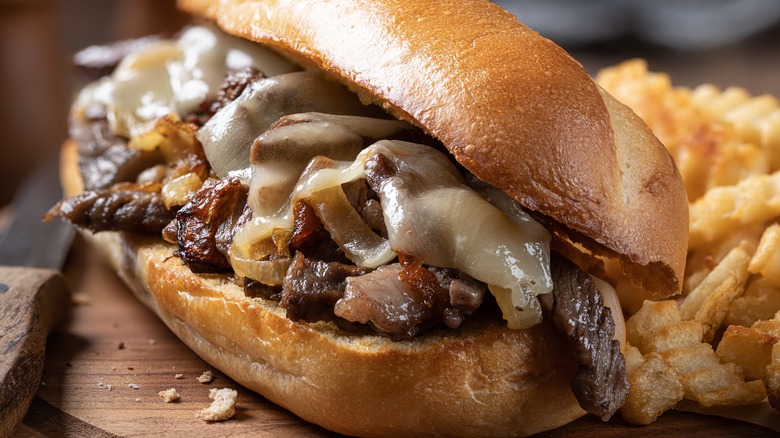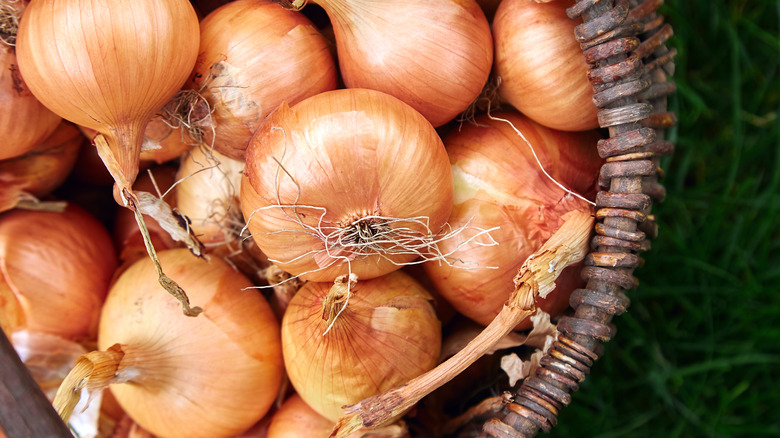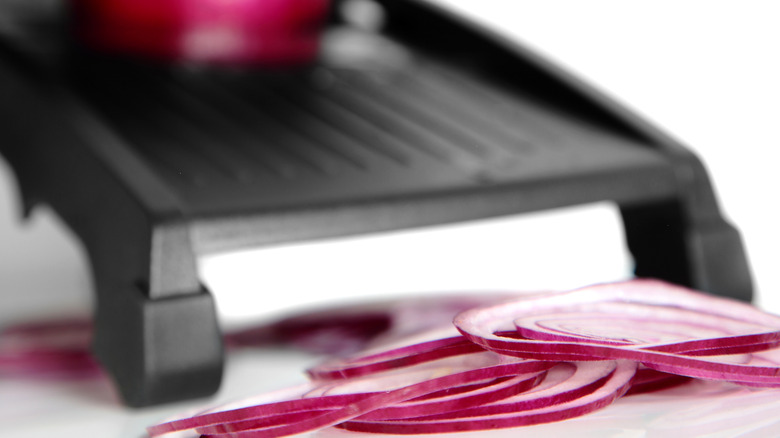The Absolute Best Way To Prepare Onions For A Classic Philly Cheesesteak
Eating an authentic Philly cheesesteak is a singular experience. A crusty roll groans beneath the weight of melted cheese-laden piles of thinly-sliced beef and grilled onions — each bite a glorious mess becoming soggier and more irresistible by the mouthful. This iconic sandwich was serendipitously invented by Pat Olivieri in 1930, who back then ran a little hot dog stand in the City of Brotherly Love that has since become — and still remains – Pat's King of Steaks, home of the real deal.
Times have changed, and so have cheesesteaks, but our love for them has never wavered. There are many variations on the original — eateries like Geno's and Charleys offer a scrumptious selection — but the core toppings of meat, onions, and cheese are constants. Today's cheesesteaks can (barely) contain everything from shaved, marble-y ribeye to sirloin to top round or even (purist cringe alert) processed frozen steak, per First We Feast. The choice of cheese stirs up even further controversy, with diehards clamoring for Cheez Whiz (is that even cheese?) despite provolone being cited as Olivieri's original innovation, according to Charleys, and being slightly better at holding that mountain of goodness into a manageable form.
Amidst all the debate and bitter rivalry, the humble onions are an easily-overlooked yet crucial element of this beloved American food. But if you've got your foodie heart set on making a classic Philly cheesesteak at home, you simply must do the onions justice. Do it for Pat. Do it for Philadelphia! Here's the best way to prepare onions for your cheesesteak — the why, and the how.
Why you should care about onions on your Philly cheesesteak
If you're going for the genuine article, say Pat's and the other key players, then your cheesesteak must have onions. That's what Olivieri, Father of the Cheesesteak, intended (sorry, peppers and mushrooms — onions were there even before cheese was added!). They even have their own catchphrase: according to the Philadelphia Inquirer, the proper lingo for ordering onions on your cheesesteak is to request a "cheesesteak wit." It's easy to see why onions are so popular: Though they're infamous for making us cry, onions are also a healthy and versatile ingredient, says Healthline, that adds flavor to dishes and pairs wonderfully with meat.
Onions' culinary contribution to the cheesesteak comes from a reaction that occurs at the high temperature at which they're grilled or fried — at least 250 degrees Fahrenheit, says fine food purveyor D'Artagnan. As the onions brown, their natural sugars — which are present in all foods, according to D'Artagnan — caramelize, creating a deeper flavor and mouthwatering aroma. This delicious phenomenon is a chemical process known as the Maillard reaction. If you want to expedite the caramelization, there are shortcuts like J. Kenji López-Alt's from Serious Eats, or you could just opt for a ripping-hot cooking surface to get the job done, as many restaurants do.
How to prepare onions for Philly cheesesteak
So, say you want to add this venerable and divisive sandwich to your culinary repertoire and make it yourself. A good visual guide to chopping onions the traditional way is useful if you prefer diced onions or horizontal (crosswise) slices that will wilt but keep some crunch. But for classic, melty caramelized onions, Simply Recipes states that you should cut the onion lengthwise (end to end) so they can soften and break down more thoroughly while retaining their basic shape.
Regardless, the most important thing is that the onions are sliced as thinly and evenly as possible so they can more easily get all tender and caramelized (but keep in mind that they will shrink a bit during cooking). If you have a deli slicer or a mandoline (not the mandolin instrument — that would be awful), the task will be easier. Once they're sliced, heat up your pan over high heat, get it good and hot, and add your cooking oil, turning the stove down to medium-high. Toss in your onions and stir them regularly, cooking until they're browned and at your desired level of tenderness, says First We Feast. Add salt to taste and set them aside while you tackle the rest of the recipe. And there you have it — the perfect onions for a homemade Philly cheesesteak, served with a side of history.


